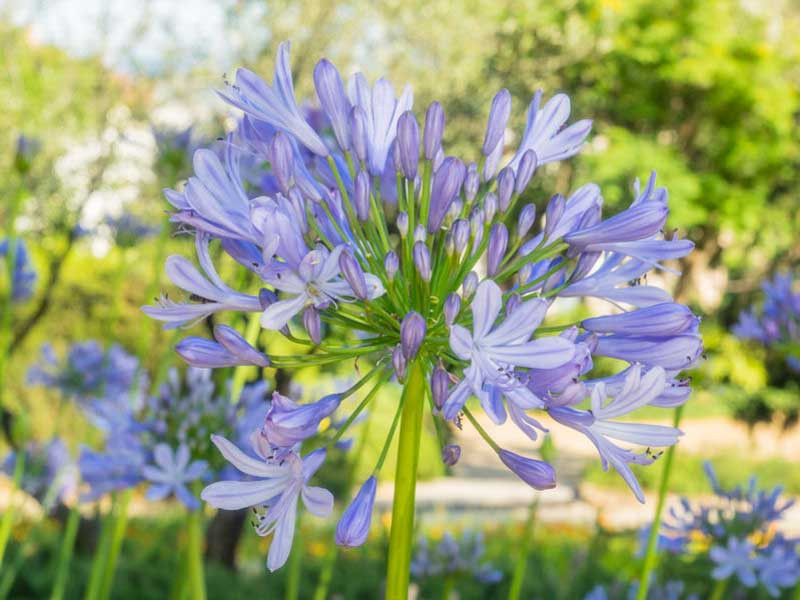Letting Loose the Secret to Successful Agapanthus Cultivation: Idea for a Flourishing Yard
In the realm of gardening, growing agapanthus efficiently calls for a tactical strategy that includes different aspects of plant treatment. With cautious focus to information, one can open the keys to nurturing these magnificent flowers, causing a garden that flourishes with appeal and vibrancy. By recognizing the nuances of agapanthus growing, one can create an atmosphere where these plants prosper and flower perfectly. In the complying with discussion, we will certainly discover crucial suggestions and techniques that will lead you in the direction of a prospering agapanthus yard, offering insights right into best methods, dirt problems, watering techniques, and more.
Planting Agapanthus: Finest Practices
When growing Agapanthus, appropriate soil preparation is vital for making sure effective growth and growth of these attractive blossoms. Agapanthus, frequently understood as Lily of the Nile or African lily, flourishes in well-draining soil with a slightly acidic to neutral pH level - Agapanthus. Prior to planting, it is crucial to amend heavy clay soils with organic matter such as garden compost or peat moss to improve drain and provide important nutrients for the plants
To grow Agapanthus, choose a place that obtains full sunlight to partial shade, as this will advertise healthy and balanced growth and plentiful blooming. Dig an opening twice the size of the plant's origin ball and put the Agapanthus at the exact same depth it was previously expanding. Carefully backfill the opening with soil, weighing down firmly to get rid of any type of air pockets around the roots.
Water the freshly planted Agapanthus extensively and remain to maintain the dirt evenly moist, especially throughout the plant's active growing season. Agapanthus. Applying a well balanced plant food once a month can further support the plant's growth and blooming. By complying with these finest techniques for growing Agapanthus, you can produce a magnificent display screen of these fascinating blossoms in your yard
Suitable Soil Conditions for Agapanthus
For ideal development and growing success of Agapanthus plants, ensuring the soil problems are excellent is critical. Agapanthus flourishes in well-draining dirt with a somewhat acidic to neutral pH level ranging from 6.0 to 7.0. This kind of soil permits appropriate water drainage, avoiding waterlogging which can bring about root rot. To enhance soil drain, think about including raw material such as garden compost or peat moss when preparing the planting website. Furthermore, Agapanthus favors dirt that is rich in nutrients, so integrating a balanced fertilizer during the expanding period can advertise healthy growth and vivid blooms.

Watering and Fertilizing Tips
To guarantee healthy development and vivid flowers, appropriate watering and feeding methods are necessary for effective Agapanthus growing. Agapanthus plants profit from regular watering, particularly during the growing period.
When it pertains to fertilizing Agapanthus, a balanced fertilizer with equal parts nitrogen, phosphorus, and potassium can be applied in the spring to promote healthy and balanced development and flowering. Slow-release fertilizers are excellent for giving nutrients slowly over a prolonged duration. Prevent over-fertilizing, as this can cause extreme foliage growth at the cost of blooms.
Additionally, incorporating natural matter like garden compost right into the dirt can improve nutrient degrees and boost soil structure, helping in the total wellness of the Agapanthus plants. By adhering to these watering and feeding ideas, garden enthusiasts can ensure their Agapanthus plants flourish and produce sensational displays of flowers.
Trimming and Deadheading Techniques
Proper pruning and deadheading methods play a critical function in keeping the health and wellness and appearances of Agapanthus plants, matching the essential techniques of watering and fertilizing for successful growing. Pruning Agapanthus includes getting rid of spent flower heads, yellowing or dead leaves, and total shaping of the plant to advertise better growth. Deadheading, the process of getting rid of discolored flowers, not only boosts the plant's appearance however additionally encourages more blooming.
When deadheading Agapanthus, it is suggested to clip off the blossom stem at the base utilizing sharp, tidy shears. This procedure redirects the plant's energy from seed production back into origin and foliage growth, promoting a healthier and much more durable plant. Routine deadheading can expand the blooming duration of Agapanthus and prevent self-seeding, which can lead to congestion.
In regards to trimming, Agapanthus normally gain from a light trim after blossoming to clean up the plant and motivate Continued fresh development. Reducing the invested flower stems and eliminating any dead or broken foliage aids keep the plant's vitality and general appearance. Nevertheless, it is vital to prevent cutting right into the crown of the plant, as this can compromise its health.

Protecting Agapanthus From Vermins and Diseases
Carrying out reliable insect and illness administration strategies is crucial to securing the health and wellness and vigor of Agapanthus plants in farming. Agapanthus are typically hardy plants, however they can still come down with numerous bugs and diseases if not properly cared for. One common bug that influences Agapanthus is the Agapanthus borer, a caterpillar that passages into the plant, triggering damage to the flowers and fallen leaves. To avoid problems, routine assessment of the plants is essential. If borers are detected, they can be by hand eliminated, or my website insecticidal soap can be used as a control action.
Along with parasites, Agapanthus are vulnerable to illness such as root rot and fungal fallen leave spots. These issues can commonly be avoided by ensuring appropriate water drainage and avoiding overwatering. Impacted components of the plant need to be immediately eliminated to stop additional spread if signs of disease appear. Fungicides might additionally be utilized as a treatment step, following the manufacturer's instructions thoroughly. By staying attentive and attending to insect and disease issues immediately, garden enthusiasts can help their Agapanthus grow and prosper.

Conclusion
To conclude, successful farming of agapanthus requires correct planting techniques, ideal soil conditions, sufficient watering and feeding, routine trimming and deadheading, and defense from illness and parasites. By adhering to these tips and techniques, gardeners can ensure a growing garden filled with gorgeous agapanthus blossoms. Agapanthus. Remember to preserve consistent treatment and interest to information to promote the wellness and long life of these spectacular plants
When planting Agapanthus, appropriate soil preparation is crucial for ensuring effective growth and growth of these beautiful blossoms.Water the recently planted Agapanthus extensively and proceed to keep the dirt uniformly wet, especially during the plant's additional hints energetic expanding season.For optimal growth and blooming success of Agapanthus plants, ensuring the dirt conditions are optimal is crucial. When hair transplanting or growing Agapanthus, ensure the soil is well-prepared to give the essential structure for the plants to develop themselves successfully. One usual parasite that influences Agapanthus is the Agapanthus borer, a caterpillar that passages into the plant, causing damages to the blossoms and leaves.